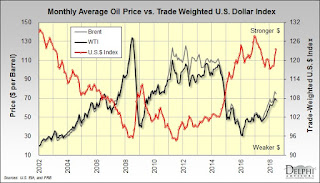Click image
for larger view
Click image
for larger view
Sales of new
single-family houses in June 2018 were at a seasonally adjusted annual rate (SAAR)
of 631,000 units (669,000 expected).
This is 5.3% (±17.1%)* below the revised May rate of 666,000 (originally 689,000
units), but 2.4% (±24.0%)* above the June 2017 SAAR of 616,000 units; the
not-seasonally adjusted year-over-year comparison (shown in the table above)
was +1.8%. For longer-term perspectives, not-seasonally adjusted sales were 54.6%
below the “housing bubble” peak but 9.0% above the long-term, pre-2000 average.
The
median sales price of new houses sold in June was $302,100 (-$7,600 or 2.5% MoM);
meanwhile, the average sales price retreated to $363,300 (-$1,800 or 0.5%). Starter
homes (defined here as those priced below $200,000) comprised 15.8% of the
total sold, up from the year-earlier 12.5%; prior to the Great Recession
starter homes represented as much as 61% of total new-home sales. Homes priced
below $150,000 made up 3.5% of those sold in June, little changed from 3.6% a
year earlier.
* 90% confidence interval includes zero.
The Census Bureau does not have sufficient statistical evidence to conclude
that the actual change is different from zero.
Click image
for larger view
As
mentioned in our post
about housing permits, starts and completions in June, single-unit completions fell
by 20,000 units (-2.3%). Although the drop in sales (-35,000 units; 5.3%)
outpaced that of completions, inventory for sale expanded in both absolute (+4,000
units) and months-of-inventory terms (+0.4 month).
Click image
for larger view
Existing home sales
fell by 30,000 units (-0.6%) in June, to a SAAR of 5.38 million units (5.450
million expected).
Inventory of existing homes for sale also expanded in absolute and
months-of-inventory terms (+80,000 units; +0.2 month). Although new-home sales decreased
more slowly than existing-home sales, the share of total sales comprised of new
homes ticked down to 10.5%. The median price of previously owned homes sold in June
rose to a new record-high $276,900 (+$11,800 or 2.7% MoM).
Click image
for larger view
Housing
affordability degraded further as the median price of existing homes for
sale in May jumped by $7,700 (+3.0%; +5.2 YoY), to $267,500. Concurrently,
Standard & Poor’s
reported that the U.S. National Index in the S&P Case-Shiller CoreLogic Home
Price indices posted a not-seasonally adjusted monthly change of +1.1% (+6.4% YoY)
-- marking a new all-time high for the index.
“Home
prices continue to rack up gains two to three times greater than the inflation
rate,” said David
Blitzer, Managing Director & Chairman of the Index Committee at S&P
Dow Jones Indices. “The YoY increases in the S&P CoreLogic Case-Shiller National
Index have topped 5% every month since August 2016. Unlike the boom-bust period
surrounding the financial crisis, price gains are consistent across the 20
cities tracked in the release; currently, the range of the largest to smallest
price change is 10 percentage points (PP) compared to a 20PP range since 2001,
and a 25PP range between 2006 and 2009. Not only are prices rising
consistently, they are doing so across the country.
“Continuing
price increases appear to be affecting other housing statistics. Sales of
existing single family homes -- the market covered by the S&P CoreLogic
Case-Shiller Indices -- peaked last November and have declined for three months
in a row. The number of pending home sales is drifting lower as is the number
of existing homes for sale. Sales of new homes are also down and housing starts
are flattening. Affordability -- a measure based on income, mortgage rates and
home prices -- has gotten consistently worse over the last 18 months. All these
indicators suggest that the combination of rising home prices and rising
mortgage rates are beginning to affect the housing market.”
Click image
for larger view
The foregoing comments represent the
general economic views and analysis of Delphi
Advisors, and are provided solely for the purpose of information, instruction
and discourse. They do not constitute a solicitation or recommendation
regarding any investment.





















































